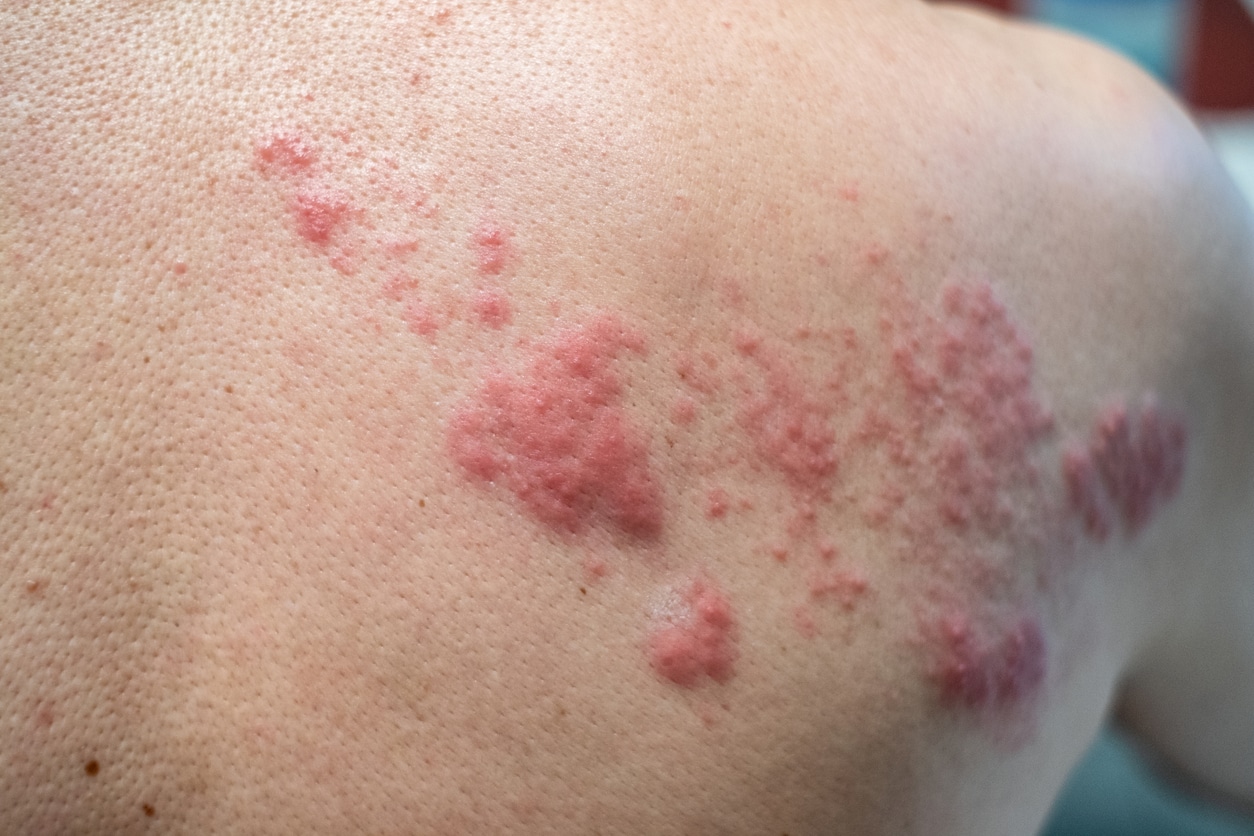Shingles
Shingles: Expert Diagnosis and Comprehensive Management
Shingles, medically known as Herpes Zoster, is a painful viral infection that results in a distinct, blistering rash. It is caused by the reactivation of the Varicella-Zoster Virus (VZV), the same virus that causes chickenpox. A Shingles outbreak is characterized by intense, localized pain and the appearance of a rash that follows nerve pathways.
At White Rock Dermatology, our board-certified dermatologists, Dr. Beth Dolan and Dr. Christy Riddle, understand that Shingles is not just a skin condition—it’s a neurological event that requires swift, specialized medical intervention. Time is a critical factor in treating Shingles, as prompt intervention is necessary to reduce the severity of the outbreak and significantly minimize the risk of developing long-term nerve pain. If you suspect you have Shingles, immediate contact with our office is strongly advised.

Understanding the Cause of Shingles
After a person recovers from chickenpox, the VZV does not leave the body. Instead, it lies dormant (inactive) in the nerve tissue near the spinal cord and brain. A Shingles episode occurs when this virus reactivates and travels down the nerve fibers to the skin.
Common Triggers for Viral Reactivation:
- Age: The risk increases significantly with age, particularly for individuals over 50.
- Weakened Immunity: Temporary or chronic weakening of the immune system due to illness, medications, or prolonged stress.
- Stress: Significant emotional or physical stress can sometimes trigger the virus to travel down the nerve.
Because the virus follows a specific nerve path (dermatome), the resulting rash typically appears as a band or stripe, localized to one side of the body, and almost never crossing the body’s midline.
Recognizing the Key Stages of a Shingles Outbreak
Identifying Shingles quickly is essential for starting treatment during the critical therapeutic window. The infection generally progresses through these stages:
1. Prodrome Stage (Pre-Rash Symptoms)
This stage involves localized symptoms that often occur 1 to 5 days before the rash becomes visible. Patients may mistake this for a muscle strain or another internal issue.
-
Localized burning, tingling, or stabbing pain in a specific area.
-
Intense itching or sensitivity to touch.
-
General fatigue or headache.
2. Active Rash Stage
This stage confirms the Shingles diagnosis and signals the urgency for treatment.
-
Rash Appearance: Red patches and clusters of small, fluid-filled blisters (vesicles) emerge along the affected nerve pathway.
-
Pattern: The rash is distinct—a band or strip on only one side of the body.
-
Progression: Blisters typically crust over within 7 to 10 days and heal completely over 2 to 4 weeks.
The White Rock Dermatology Treatment Philosophy
Our main goal in managing a Shingles outbreak is two-fold: viral suppression and nerve protection.
Immediate Antiviral Therapy
Treatment should ideally begin within 72 hours of the rash first appearing. Starting oral antiviral medication (such as Valacyclovir) quickly is scientifically proven to:
-
Speed up the healing time of the skin lesions.
-
Lessen the severity and duration of the acute pain.
-
Significantly reduce the risk of developing chronic pain.
Comprehensive Pain and Symptom Management
We provide a multi-faceted approach to manage the severe nerve pain associated with Shingles, which includes:
-
Pain Control: Prescribing oral medications, which may include neuropathic agents, to manage acute nerve pain and inflammation.
-
Topical Care: Recommendations for soothing, localized treatments to dry the blisters, prevent bacterial infection, and alleviate itching.
-
Nerve Protection: Strategically managing the acute inflammatory response to protect the nerve from long-term damage.
Preventing Chronic Nerve Pain: Postherpetic Neuralgia (PHN)
The most serious long-term consequence of Shingles is Postherpetic Neuralgia (PHN). PHN is defined as chronic, persistent nerve pain that lingers in the area of the rash even after the skin has fully healed. This pain can be debilitating. Our aggressive management during the acute phase is focused on mitigating the risk of developing this chronic condition.
Proactive Prevention: The Zoster Vaccine
The most effective way to prevent a Shingles episode and its severe complications is through vaccination. The current recommended vaccine is highly effective and advised for:
-
All healthy adults aged 50 and older.
-
Adults aged 19 and older who are or will be immunodeficient.
We encourage eligible patients to discuss the vaccine with our physicians during their next skin cancer screening or routine visit.
Seek Expert Care Immediately
When dealing with a painful condition like Shingles, quick, accurate medical care is paramount. As board-certified dermatologists, Dr. Dolan and Dr. Riddle have the expertise to confirm the diagnosis, manage pain effectively, and initiate life-changing antiviral therapy within the critical time window.
If you suspect you are developing Shingles, contact White Rock Dermatology immediately. Visit our Contact Page or our Request an Appointment page to receive prompt, specialized care.
